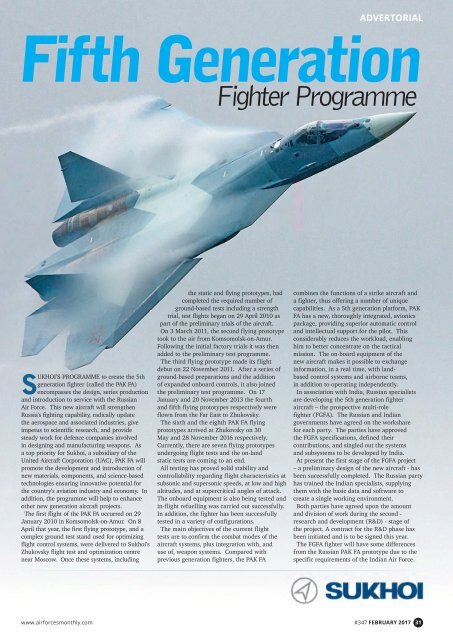Airforces Monthly - February 2017
You also want an ePaper? Increase the reach of your titles
YUMPU automatically turns print PDFs into web optimized ePapers that Google loves.
ADVERTORIAL<br />
Fifth Generation<br />
Fighter Programme<br />
SUKHOI’S PROGRAMME to create the 5th<br />
generation fighter (called the PAK FA)<br />
encompasses the design, series production<br />
and introduction to service with the Russian<br />
Air Force. This new aircraft will strengthen<br />
Russia's fighting capability, radically update<br />
the aerospace and associated industries, give<br />
impetus to scientific research, and provide<br />
steady work for defence companies involved<br />
in designing and manufacturing weapons. As<br />
a top priority for Sukhoi, a subsidiary of the<br />
United Aircraft Corporation (UAC), PAK FA will<br />
promote the development and introduction of<br />
new materials, components, and science-based<br />
technologies ensuring innovative potential for<br />
the country's aviation industry and economy. In<br />
addition, the programme will help to enhance<br />
other new generation aircraft projects.<br />
The first flight of the PAK FA occurred on 29<br />
January 2010 in Komsomolsk-on-Amur. On 8<br />
April that year, the first flying prototype, and a<br />
complex ground test stand used for optimizing<br />
flight control systems, were delivered to Sukhoi’s<br />
Zhukovsky flight test and optimization centre<br />
near Moscow. Once these systems, including<br />
the static and flying prototypes, had<br />
completed the required number of<br />
ground-based tests including a strength<br />
trial, test flights began on 29 April 2010 as<br />
part of the preliminary trials of the aircraft.<br />
On 3 March 2011, the second flying prototype<br />
took to the air from Komsomolsk-on-Amur.<br />
Following the initial factory trials it was then<br />
added to the preliminary test programme.<br />
The third flying prototype made its flight<br />
debut on 22 November 2011. After a series of<br />
ground-based preparations and the addition<br />
of expanded onboard controls, it also joined<br />
the preliminary test programme. On 17<br />
January and 20 November 2013 the fourth<br />
and fifth flying prototypes respectively were<br />
flown from the Far East to Zhukovsky.<br />
The sixth and the eighth PAK FA flying<br />
prototypes arrived at Zhukovsky on 30<br />
May and 28 November 2016 respectively.<br />
Currently, there are seven flying prototypes<br />
undergoing flight tests and the on-land<br />
static tests are coming to an end.<br />
All testing has proved solid stability and<br />
controllability regarding flight characteristics at<br />
subsonic and supersonic speeds, at low and high<br />
altitudes, and at supercritical angles of attack.<br />
The onboard equipment is also being tested and<br />
in-flight refuelling was carried out successfully.<br />
In addition, the fighter has been successfully<br />
tested in a variety of configurations.<br />
The main objectives of the current flight<br />
tests are to confirm the combat modes of the<br />
aircraft systems, plus integration with, and<br />
use of, weapon systems. Compared with<br />
previous generation fighters, the PAK FA<br />
combines the functions of a strike aircraft and<br />
a fighter, thus offering a number of unique<br />
capabilities. As a 5th generation platform, PAK<br />
FA has a new, thoroughly integrated, avionics<br />
package, providing superior automatic control<br />
and intellectual support for the pilot. This<br />
considerably reduces the workload, enabling<br />
him to better concentrate on the tactical<br />
mission. The on-board equipment of the<br />
new aircraft makes it possible to exchange<br />
information, in a real time, with landbased<br />
control systems and airborne teams,<br />
in addition to operating independently.<br />
In association with India, Russian specialists<br />
are developing the 5th generation fighter<br />
aircraft – the prospective multi-role<br />
fighter (FGFA). The Russian and Indian<br />
governments have agreed on the workshare<br />
for each party. The parties have approved<br />
the FGFA specifications, defined their<br />
contributions, and singled out the systems<br />
and subsystems to be developed by India.<br />
At present the first stage of the FGFA project<br />
– a preliminary design of the new aircraft - has<br />
been successfully completed. The Russian party<br />
has trained the Indian specialists, supplying<br />
them with the basic data and software to<br />
create a single working environment.<br />
Both parties have agreed upon the amount<br />
and division of work during the second -<br />
research and development (R&D) - stage of<br />
the project. A contract for the R&D phase has<br />
been initiated and is to be signed this year.<br />
The FGFA fighter will have some differences<br />
from the Russian PAK FA prototype due to the<br />
specific requirements of the Indian Air Force.<br />
www.airforcesmonthly.com<br />
#347 FEBRUARY <strong>2017</strong><br />
31


